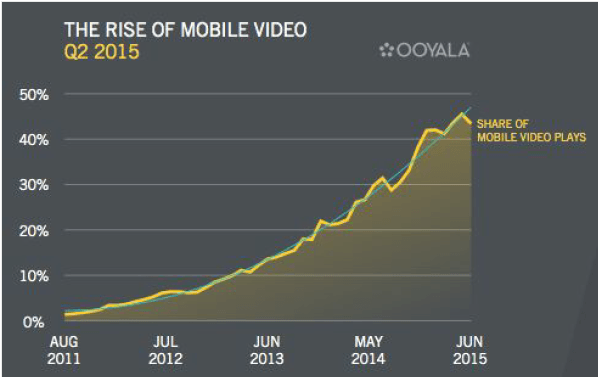Video: It’s Everywhere
Video is taking over!
Recent and ongoing advances in camera and streaming technologies have opened increasingly broad access to video for consumers. Almost everywhere you look, brands have been increasing their use of this highly engaging medium to better connect with their customers. This increase can be described in one word: revolutionary.
Recently, we’ve seen social media platforms change their layouts and functionality to better suit video. Twitter has incorporated landing videos in their “Moments” section. Apps like Periscope have risen sharply in popularity in just months. In July 2015, Periscope users were watching 40 years’ worth of videos every day, and those numbers increase every day. Even Facebook has seen a sharp rise in the usage of video content, which is one reason they have incorporated autoplay in their platform. Between April 2015 and November 2015, the amount of average daily video views on Facebook doubled from 4 billion to 8 billion.
Faster phones, along with faster networks and internet connections, have allowed the masses to stream HD video quickly and easily. Midway through 2015, mobile video plays exceeded 44%, up 74% from 2014 and up a whopping 844% since 2012. What’s more amazing is that these increases don’t look like they’re going to slow down anytime soon. Cisco is currently predicting that 80% of internet traffic will be video by 2018.
 This is Great News For Web Marketers
This is Great News For Web Marketers
When it comes to web advertising and marketing, we can see the immense benefit video has in regards to content and marketing strategies:
- 70% of marketers claim videos produce more conversions than any other content.
- 51.9% of marketing professionals worldwide name video as the type of content with the best ROI
- Shoppers who view video are 1.81X more likely to purchase than non-viewers.
- Using the word "video" in an email subject line boosts open rates by 19%, click-through rates by 65% and reduces unsubscribes by 26%
- Companies using video enjoy 41% more web traffic than non-video users
- Video on landing pages can increase conversion by 80% or more (homepage video increase conversions by 20% or more)
- Businesses using video grow revenue 49% faster year-over-year than organizations without video
- Video drives a 157% increase in organic traffic from search engines
- 4.8% is the average conversion rate for companies using video compared to 2.9% for those who do not.
- 74% of millennials find video helpful when comparison shopping.
- 40% of consumers state that video increases the chance they'll purchase a product on their mobile device.
- 4X as many consumers would rather watch a video about a product than read about it.
Doing Video Right
Although the numbers are strongly in favor of video content, it’s important to remember that just having video won’t yield the results. For example, 62% of consumers are more likely to have a negative perception of a brand that published a poor quality video.
When most companies begin to use video as a content strategy, their initial action is to get across rational arguments, tangible data, and stats quicker to the consumer. For example, take a product or service’s attributes or capabilities, and put it in video form to get the information across quicker and in a more visually appealing way. There is a great benefit in approaching video that way, but there is also a more effective way: emotion.
Studies have found that factors influencing purchasing are 80% emotional and 20% rational.These studies have been backed up using MRI scans of the brain during a purchase decision.The part of the brain that processes emotion is almost always the deciding factor when rational thought is left behind.
So how do we create emotion using video?
The best way to create an emotional connection to a business and brand is storytelling. Storytelling can take on many shapes and sizes. It can be narrative or visual, happy or sad, avant garde or classical, but the one thing it must follow is Freytag’s story structure: Exposition, Rising Action, Climax, Falling Action, and Denouement.
Neuroeconomics pioneer Paul Zak has well documented the connection between story, emotion, and sales in this great video:
In simplistic terms, when a story is properly told it directly affects and “wakes up” the parts of the brain that process emotion. Once we have accessed that part of the brain, we have made an emotional connection with the audience that will make a long and lasting impression.
Understanding that purchasing decisions are 80% emotional and 20% rational, a good story has greatly increased your chances to sell a product.
If you haven’t thought about including or updating video in your marketing strategy, it might be time.
This blog was written by Michael Habschmidt, Co-Owner and Creative Director of Two Gents Digital.